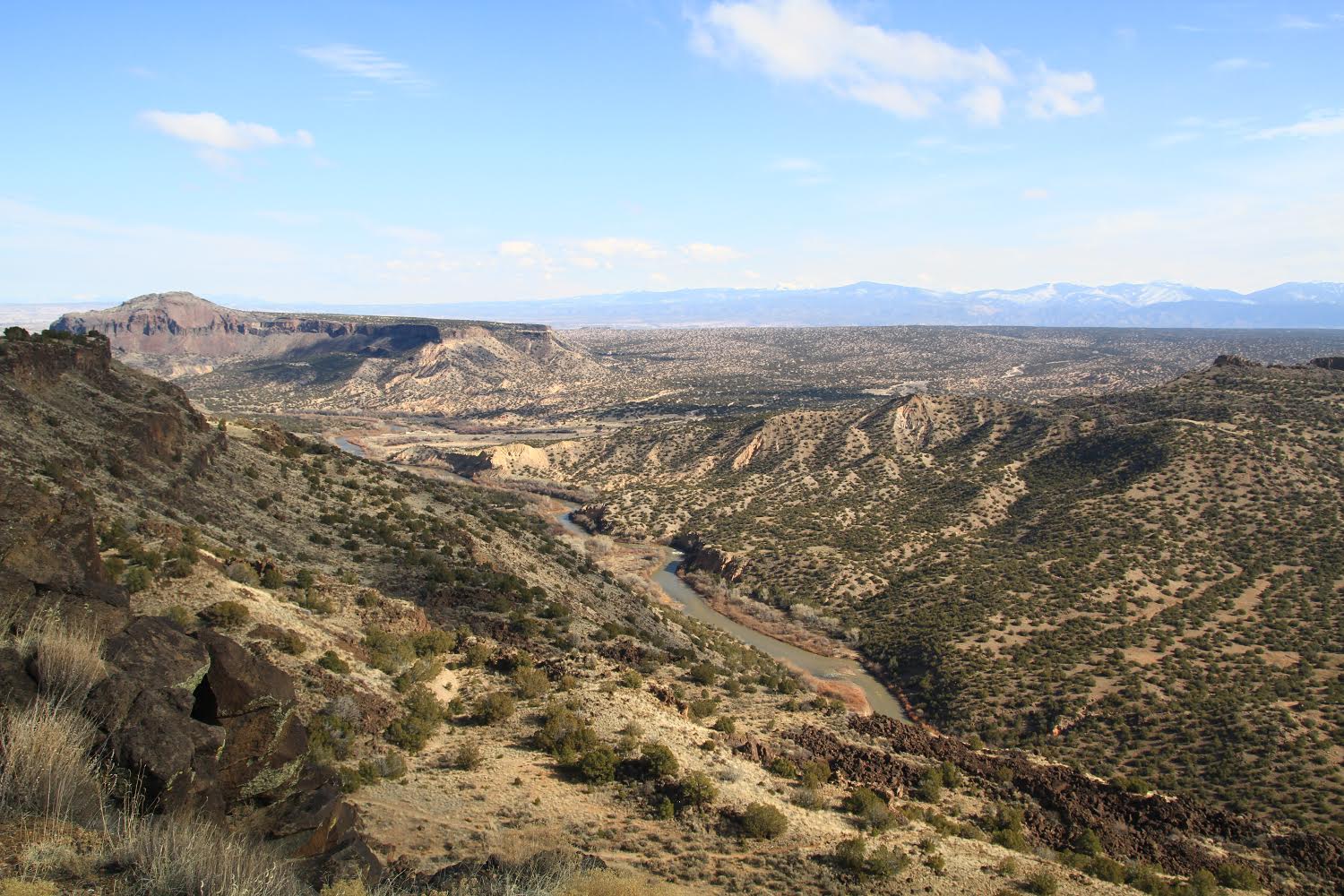Taking the temperature of streamflow forecasts
Climate information improves forecast accuracy in the U.S. Southwest
Feb 21, 2018 - by Laura Snider
Feb 21, 2018 - by Laura Snider

The upper Rio Grande River watershed near Los Alamos, New Mexico. (Image: Flavio Lehner, NCAR)
February 21, 2018 | Adding temperature predictions into seasonal streamflow forecasts in the U.S. Southwest could increase the accuracy of those forecasts, according to a new study that analyzed historical conditions in the headwaters of the Colorado and Rio Grande rivers.
Many rivers in the western United States are fed by melting snow in the spring and summer. Regional water managers depend on seasonal water supply forecasts that estimate the amount of runoff the snowpack will yield to determine how much water to allocate to farmers and ranchers, city residents, and other users.
These forecasts, which are based on snowpack measurements taken in the winter and spring, tend to assume that the climate is stable and that the relationship between the amount of snowpack and the amount of runoff is also stable.
But a recent study by scientists at the National Center for Atmospheric Research (NCAR), the National Oceanic and Atmospheric Administration (NOAA), and the Bureau of Reclamation found that warmer temperatures reduce the amount of meltwater that actually makes it into a stream, a finding that highlights the importance of accounting for changing climate conditions when forecasting streamflow.
Building on this work, scientists at NCAR tested whether incorporating seasonal temperature predictions into statistical streamflow forecasting models could improve their accuracy. The temperature predictions reflect the recent warming trend as well as whether the months after the forecast date are likely to be warmer or colder than this trend. Results of the new study were published in the journal Geophysical Research Letters.
"Adding temperature predictions into streamflow forecasts will not only improve the information that water managers have today, but it also has the potential to mitigate some of the loss of predictability that we now expect in the future, as the climate continues to warm," said NCAR scientist Flavio Lehner, who co-led the study with NCAR scientist Andy Wood.
The research contributes to an NCAR effort, in collaboration with several federal agencies, to build better tools and models for analysis and prediction of water resources. The new study was funded by the NOAA, the Bureau of Reclamation, and the U.S. Army Corps of Engineers.
Other study co-authors include Angus Goodbody from the National Water and Climate Center, which issues streamflow forecasts for the western United States; Florian Pappenberger from the forecast department of the European Centre for Medium-Range Weather Forecasts; and Douglas Blatchford and Dagmar Llewellyn, both from the Bureau of Reclamation.
To test whether the addition of seasonal temperature predictions could improve streamflow forecasts, the scientists created "hindcasts" for the headwaters of the Colorado and Rio Grande Rivers (both located in Colorado) for the three decades between 1987 and 2016.
The team used historical observations of snowpack, precipitation, and streamflow to issue and evaluate a series of forecasts — on Jan. 1, Feb. 1, March 1, April 1, and May 1 — for each year. These hindcasts emulate the current method of issuing streamflow forecasts, including the calendar dates when those forecasts are issued.
The scientists also issued a second set of hindcasts, this time with the addition of seasonal temperature predictions for the region. The seasonal predictions were drawn from the North American Multi-Model Ensemble and the European Centre for Medium-Range Weather Forecasts, which together comprise eight state-of-the-art models used for seasonal climate forecasts.
The team found that incorporating temperature predictions improved the accuracy of seasonal streamflow forecasts at the majority of river gauges across the headwaters of both basins. The amount of improvement varied between about 1 percent and 10 percent, averaged across the basins.
"We think that model-based temperature predictions could be used to improve water supply forecasts in other watersheds that rely on runoff from snowpack — across the western United States and in other parts of the world," Lehner said "But the degree of improvement will certainly depend on the individual area."
To make it as easy as possible for existing operational forecasting centers to begin incorporating the research findings, the scientists chose to modify existing forecasting techniques to include temperature predictions instead of inventing an entirely new forecasting method.
"It's a well-known challenge to transition methods from a research experiment to an operational setting," Wood said. "Here we chose a baseline of a current operational water supply forecast technique so that the approach is an extension to the existing practice, and more likely to be supportable."
Fostering these kinds of applications is the overarching goal of the Postdocs Applying Climate Expertise program that supports Lehner's research. PACE is run by the Cooperative Programs for the Advancement of Earth System Science, a community program of the University Corporation for Atmospheric Research.
"This project has enabled stakeholders and scientists to work together directly to tackle a concrete water-related problem arising from the variability and trends we’ve observed in our regional climate," said Llewellyn, a scientist at the Bureau of Reclamation and study co-author.
Title: "Mitigating the impacts of climate non-stationarity on seasonal streamflow predictability in the U.S. Southwest"
Authors: Flavio Lehner, Andrew W. Wood, Dagmar Llewellyn, Douglas B. Blatchford, Angus G. Goodbody, Florian Pappenberger
Journal: Geophysical Research Letters, DOI: 10.1002/2017GL076043